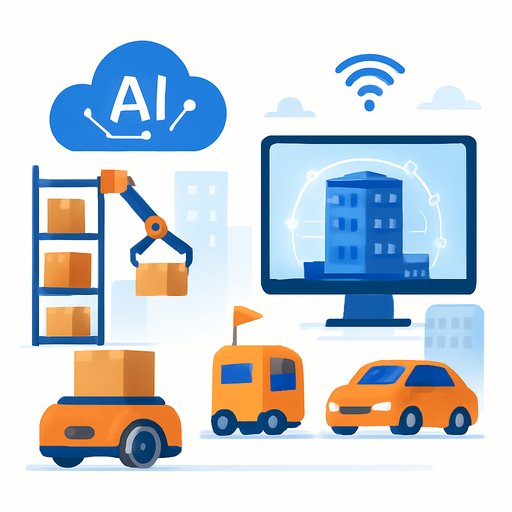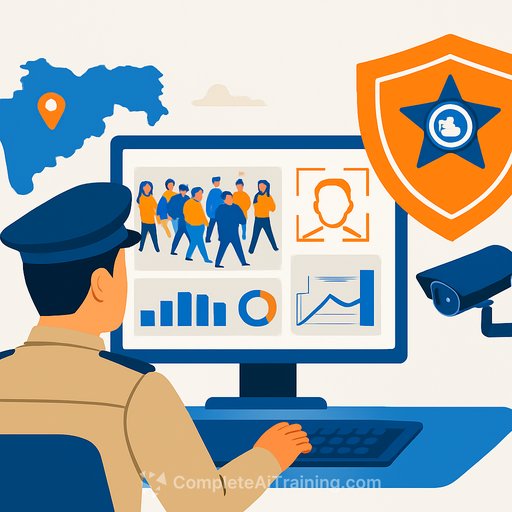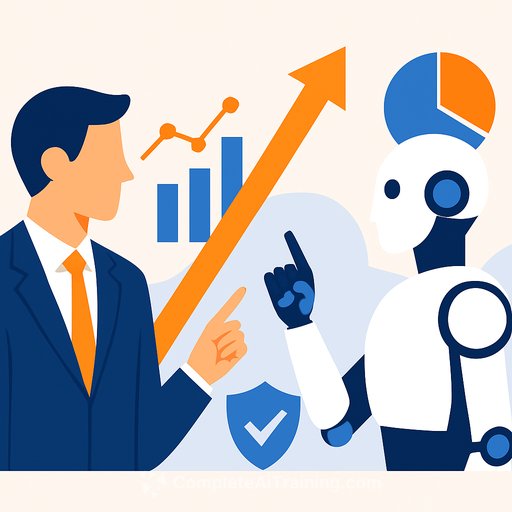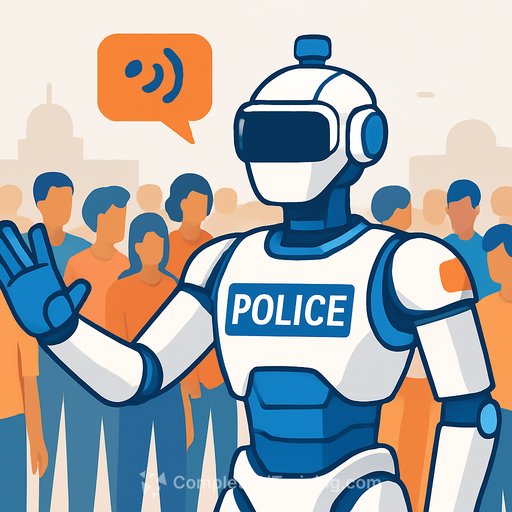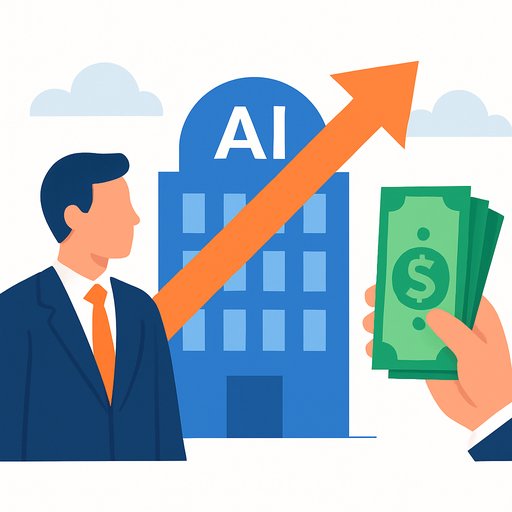AI and digital twins to manage the next wave of robots
Robot fleets are growing and getting smarter: delivery bots, service bots, drones, humanoids, and early android prototypes. As autonomy increases, so do the moving parts leaders must coordinate. AI and digital twins are emerging as the control center for this shift, helping teams plan, test and run operations before a single robot moves on the floor.
The goal is simple: fewer surprises at go-live, faster iteration in production, and safer, more efficient sites. That applies to warehouses, factories, and, over time, any complex physical environment.
What leading companies are doing right now
Nvidia introduced Mega for Omniverse Blueprint, a toolkit to design, test and improve manufacturing data centers and robot fleets inside a digital twin first. The focus: simulate humanoids, autonomous mobile robots and manipulators at scale; plan equipment placement; set routing paths; and find conflicts before they hit the real world.
The payoff is fewer layout mistakes, smoother handoffs between machines, and quicker commissioning. As Nvidia puts it: AI, robotics and digital twins will streamline logistics and reduce inefficiencies in industrial operations. See more on Nvidia Omniverse.
Hyundai's new U.S. plant leans into this model, using AI-driven robots, drones and digital twins to plan production tasks, manage inventory, and finalize inspections from day one. Building the factory around these tools from the start makes coordination a design choice, not an afterthought.
Jensen Huang summed up the direction: "Future warehouses will function like massive autonomous robots, orchestrating fleets of robots within them." Expect that idea to spread beyond logistics and manufacturing.
Humanoids: where they fit (and where they don't)
Interest in humanoids has surged. The pitch is practical: these systems can use the infrastructure built for humans-stairs, doorways, tools, and hand-sized objects-without reworking entire facilities. That can cut site retrofits and speed trials.
Rollouts will still be selective. High-repeat, high-force tasks (like screw driving at scale or heavy concrete work) will remain the domain of traditional industrial robots. Early deployments point to material handling, inspection, and simple assembly support, especially where layouts change often.
Activity is broad: Tesla's Optimus, Figure's multi-robot collaboration and voice control, plus efforts from 1X, Agility Robotics, Apptronik, Boston Dynamics, Fourier Intelligence, RobotEra and Sanctuary AI. BMW is testing Figure at Spartanburg; Mercedes is piloting Apptronik in Berlin.
As NexCobot's Jenny Shern notes, "Integrating AI to interpret human commands and dynamically generate task-specific actions is key… For an AI-powered humanoid to 'clean up the table', it needs to understand context, recognize objects and decide what to do." That's the bar for household and frontline service work.
Androids: research now, adoption later
Androids (humanoids that look and feel human) remain early. Research spans bionic muscles, electronic skins and flexible skeletons. Examples include Clone Robotics on bionic muscles, MIT work on flexible skeletons, Johns Hopkins on tactile prosthetic hands, and University of Tokyo's living skin with self-healing properties. For a sense of the pace, track updates from MIT Robotics.
Current systems still trigger the "uncanny valley" response. Expect steady improvement in movement and expression as AI models progress. Digital tools will help shape natural motion and context-appropriate behaviors before anything ships.
XR meets robotics: one control layer for digital and physical
AI turns raw sensor data into usable scene models, which feed digital twins and extended reality (XR) tools for planning and training. These environments need to accept AI-generated content to be truly effective for fleet operations and scenario testing.
Cathy Hackl puts it plainly: "As the digital and physical worlds merge, frontier technologies like spatial computing, extended reality and AI-powered wearables are ushering in a new computing paradigm." Huang expects agentic AI across glasses, humanoids and wearables to create a massive new market. The common thread: systems that observe, adapt and collaborate in real time.
What management should do next
- Pick one high-friction workflow (e.g., pallet moves, kitting, end-of-line inspection) and scope a 90-day pilot with a digital twin and a small robot fleet.
- Define your stack: fleet manager, digital twin platform, simulation engine, data pipeline, and safety monitoring. Insist on open interfaces and avoid single-vendor dead ends.
- Stand up a "sim-first" SOP: every layout change, new workflow, or robot capability is tested in the twin before physical trials.
- Set safety and oversight rules: geofences, human-in-the-loop points, escalation paths, and incident playbooks.
- Plan workforce shifts: new roles (simulation techs, robot ops), re-skilling tracks, and clear communication on how roles change-not just headcount goals.
KPIs that matter
- Throughput per hour and cycle-time variance by task
- Pick/placement accuracy and rework rate
- Mean time to recovery (MTTR) after a fault
- Energy per unit moved
- Near-miss incidents and safety stops per shift
- Sim-to-real drift: difference between simulated and actual performance
Procurement checklist (shortlist filter)
- Interoperability: ROS 2 support, OPC UA, REST/gRPC APIs
- Fleet coordination: task allocation, traffic control, mixed-vendor support
- Digital twin fidelity: physics, sensor models, scenario library, multi-agent simulation
- Data and AI: synthetic data generation, domain randomization, sim-to-real transfer
- Safety and compliance: ISO 10218/13849/TS 15066 where relevant; data security (ISO 27001); audit logs
- Edge computing: GPU availability, latency guarantees, offline operation
- Total cost of ownership: licenses, integration, updates, spares, training
Budget notes and ROI reality
Expect costs in three buckets: integration (systems work and change management), compute (edge GPUs and network), and sensors (Lidar, depth, vision). Savings show up as fewer layout errors, faster commissioning, steadier throughput, and lower incident rates.
Start with one site or one line, quantify baseline metrics, and tie savings to operational KPIs-then decide if you scale. Avoid chasing novelty for its own sake, especially with humanoids; pick jobs where variability beats fixed automation.
Risks to watch
- Vendor lock-in via proprietary simulators or fleet managers
- Overpromising humanoid capability for high-force or precision tasks
- Underinvesting in data pipelines, which stalls simulation quality
- Poor change management that blocks adoption on the floor
30-60-90 day plan
- Days 1-30: Choose pilot workflow, map current process, select vendors, define KPIs and safety gates.
- Days 31-60: Build the twin, import facility layout, model assets, run scenario tests, finalize SOPs.
- Days 61-90: Limited physical trial, compare sim vs. real, fix bottlenecks, decide on scale-up.
Bottom line
AI and digital twins give leadership a way to test decisions before they hit the floor, then run fleets with fewer surprises. Humanoids will find focused wins where human-oriented spaces and changing tasks make them useful. Android-like systems are promising but early.
Treat this as an operating model shift: simulate first, deploy small, measure hard, scale what works.
If you're building team capability for these initiatives, explore role-based programs at Complete AI Training - courses by job.
Your membership also unlocks:

